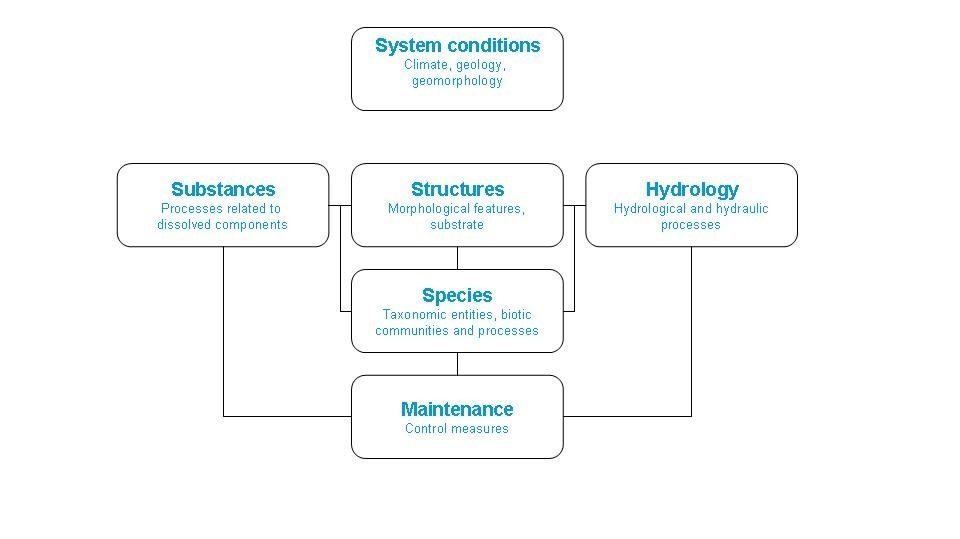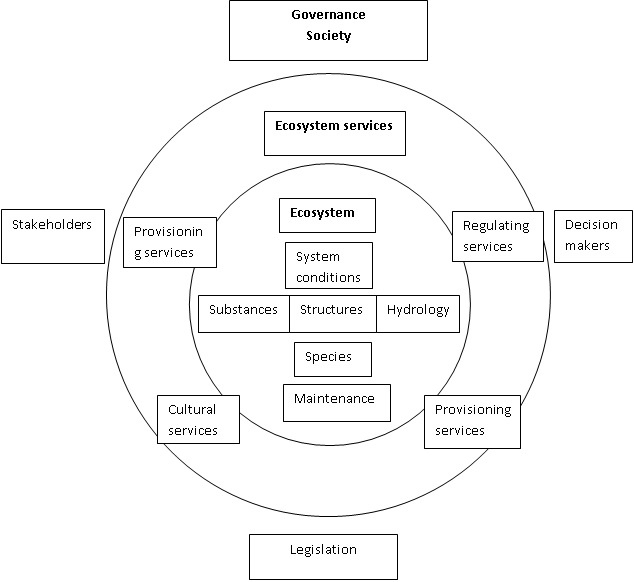How to Use
Using this tool requires generic knowledge about the type of ecosystem involved, as well as information on the system at hand. Someone with relevant ecological expertise will be able to point out the biotic and abiotic elements and processes that are characteristic for this specific ecosystem. The connection with the socio-economic and governance system can be made in a workshop with a group of people with relevant backgrounds. It is helpful if an experienced visualiser can participate in this workshop to graphically present the system and its links as discussed (also see tool Visual thinking for creative designing).
Requirements
An experienced ecologist should complete the ecological heart of the framework first. To fill in the other parts of the framework, a workshop should be organised with different experts that can discuss the characteristics and processes that should be included. The experts involved should have knowledge on the particular system at hand and have relevant fields of expertise (physics, ecology, socio-economy, governance).
To apply the tool, the Prezi cloud-based presentation software can be used. It enables zooming from a bigger picture into details of the presentation. Prezi can be used for free via the Prezi website. Prezi can be acquired as a desktop programme, but is can also be used by creating an account on the website. Tutorials on the use of the software are also available on the website. The Ecomindmap framework we developed in Prezi can be opened via this link (when using the framework, please make a copy before changing it). The Ecomindmap framework can also be used in other mindmapping software or on a whiteboard. Prezi has the advantage of an attractive layout and a zoom function.
Phased plan process

The centre of the Ecomindmap framework is based on the Dutch 5-S model with one extra component (STOWA, 1995). The inner circle is the basis for the Ecomindmap. The 5S’s are System conditions, Structures, Species, Substances and Hydrodynamics (Stroming in Dutch), which are the essential components and processes of the ecological system. Witteveen+Bos added a sixth component: Maintenance (Schonen/onderhoud in Dutch), since in most ecosystems this is an important component which influences others.
The Ecomindmap tool is applied in six steps, namely:
- Focusing on the project
- Filling in the ecosystem part
- Filling in the ecosystem services
- Filling in the ‘governance and society’ parts
- Making connections
- Discussing the Ecomindmap with project members
Step 1: focusing on the project
The user fills in the Ecomindmap for the specific project at hand. If there is a clear problem definition and a well-defined area of interest, they can be used to focus the mapping of the ecosystem. The Ecomindmap is unbiased, in that it does not deal with problems or opportunities, but just shows the current situation. If, for example, the problem is the sand deficit in the Eastern Scheldt (see also Tidal flat nourishment – Galgeplaat, NL), the Ecomindmap should focus on the process of sand distribution and the organisms depending on the intertidal shoals. When important other characteristics or processes are closely linked to these, in this case the primary production on the shoals, they can be added to the Ecomindmap.

Step 2: filling in the ecosystem part
The framework of the Ecomindmap can serve as a template for a new project. In this step, the user fills in the inner circle of the Ecomindmap, the description of the ecosystem with the 5-S-model. He/she can use the framework provided in Prezi, or any other mindmapping program, or draw it on paper. For each of the components, one should fill in the characteristics that describe the ecosystem best. These can be intact natural characteristics (that need to be protected) or degraded characteristics (that need to be restored). Use only clear words or short sentences, and if possible insert pictures or graphs to make the mindmap more visual and easier to understand. A zoom function – as in Prezi – can help focusing on more detailed characteristics of the system. Elaborated for each of the six components:
- System conditions. Climate, geology and geomorphology are factors that act on a large scale, and set the boundary conditions to the ecosystem behaviour. These factors cannot be changed by humans, except maybe on a long time scale (e.g. climate change).
- Hydrodynamics and hydrology. The hydrodynamics and hydrology are partly determined by the system conditions, and partly by the ecosystem itself. Ecosystem engineers, for instance, may influence the local flow conditions, or the ground water level. For the biotic community both are important steering factors. Hydrological processes are for example precipitation, seepage and groundwater level fluctuation. Important hydrodynamic parameters are the tidal range, the local flow velocity and the bed shear stress.
- Structures. All components of an ecosystem that shape the form of the water body are structures. The substrate gives shape to the ecosystem, for instance a system on rock will mostly be very different from one on a sand bed. A sand bank or shoal is also a structure, as are barriers, dams, guide bunds etc., and biotic elements such as oyster banks and macrophytes.
- Substances. Substances are components in the water, such as nutrients, toxins or suspended particulate matter.
- Species. Try to restrict the system description to the key species. Species can be plants and animals, ranging from single-cell algae to vascular plants and from benthos to fish to mammals. The occurrence of species depends on all other components mentioned, as the system conditions, hydrodynamics, hydrology, structures and substances form the living environment for all of them.
- Maintenance. Water managers often take control measures in water bodies to influence one of the above components (except for the system conditions). These measures can for example be dredging (affecting structures), or harvesting of bioproducts, or mowing of plants (affecting species).
Step 3: filling in the ecosystem services
The links between the ecosystem and the socio-economic system are the ecosystem services, categorised as provisioning, regulating, cultural and supporting (TEEB, 2010) (also see the tool Including natural value in decision-making – Nature Index). They help bringing ecosystem knowledge into the decision-making process. This part of the Ecomindmap can best be filled in during a project workshop by people who have different backgrounds. An environmental economist, trained in defining ecosystem services, an ecologist, a technically trained person, and a person who know the project site would make a good combination. Note that the governance and society part of the Ecomindmap will be filled in in step 4. Specialists in this field should therefore also attend the workshop for step 4.
Step 4: filling in the ‘governance and society’ parts
This part of the Ecomindmap needs to be completed in a workshop setting. This can be the same workshop during which the ecosystem services are defined (step 3). Someone with knowledge on the socio-economic system and governance is essential for this component of the mindmap. Three categories of participants/ interest groups are distinguished in this part of the Ecomindmap: stakeholders, decision-makers and legislators. In the Ecomindmap, the mapping of the socio-economic system is done in a basic way. Other knowledge and tools are available on the BwN website if you wish to do a more extensive analysis of the socio-economic and governance system. Only the stakeholders, decision-makers and legislators which are most relevant for this problem definition should be added to the Ecomindmap.
- Stakeholders: Organisations, networks and individuals that have an interest in the project, and/or the project location, are called stakeholders. Stakeholders can influence decision-making and may play a crucial role in gaining public support for the project.
- Decision-makers: The organisations or individuals who take the crucial decisions in the project or in the project area can be local, regional, national or supranational. In the case of public infrastructure development they will mostly be governmental organisations.
- Legislators: The legislators set legislative boundaries relevant to the project. Legislation can be local, regional, national or supranational. Legislation can also be a driver of a project, such as that ensuing from the European Framework Directives. This is the case for many nature restoration projects, for instance.
Step 5: making connections
A very important last step when filling in the Ecomindmap is to make connections between the different components. This can best be achieved during the same workshop as mentioned in step 3 and 4. It is advised to draw only the arrows representing the most important connections. They need to be identified by the specialists on the different topics. The more arrows (beyond a certain minimum), the more unclear the Ecomindmap becomes. A connector can be accompanied by a brief explanatory text, or by a ‘+’ or ‘-‘ sign, depending on its influence on the other component. For example, ducks eat water plants. This connector points from the ducks to the water plants and gets a minus sign.
Step 6: discussing the Ecomindmap with project members
The resulting Ecomindmap gives an overview of the most important ecological characteristics of the ecosystem at the project location, linked to the relevant ecosystem services and the socio-economic characteristics. It shows which ecological factors provide opportunities for the design, for instance fragile ecological characteristics that can be strengthened with the design, or strong characteristics that can be used to drive natural processes supporting the project realisation. Thus, it helps making the project objectives nature-inclusive. The Ecomindmap also shows the opportunities to add objectives and values and it indicates which organisations or individuals should be involved in which phase of the project. Moreover, it helps identifying important gaps in the system knowledge.
Advice and recommendations
The Ecomindmap should be seen as an instrument in the first step (‘understanding the system’) in each project phase, and especially in the initiation phase, as it creates new ideas and shows opportunities. In most projects a more thorough analysis of the ecosystem and the socio-economic system will be needed in the second instance. This can be done with other tools and knowledge available on the BwN website. The tool should be applied by people with relevant expertise for each step, and steps 3 through 6 should be carried out in an expert workshop. Relevant knowledge is needed in order to focus on the most important characteristics and processes. Different backgrounds ensure that the right connections between the system components can be made. The resulting Ecomindmap should give a clear overview of the ecological system and its connections to the socio-economic system and the relevant ecosystem services. It does not not need to be complete, selecting the relevant characteristics is what makes it valuable.
